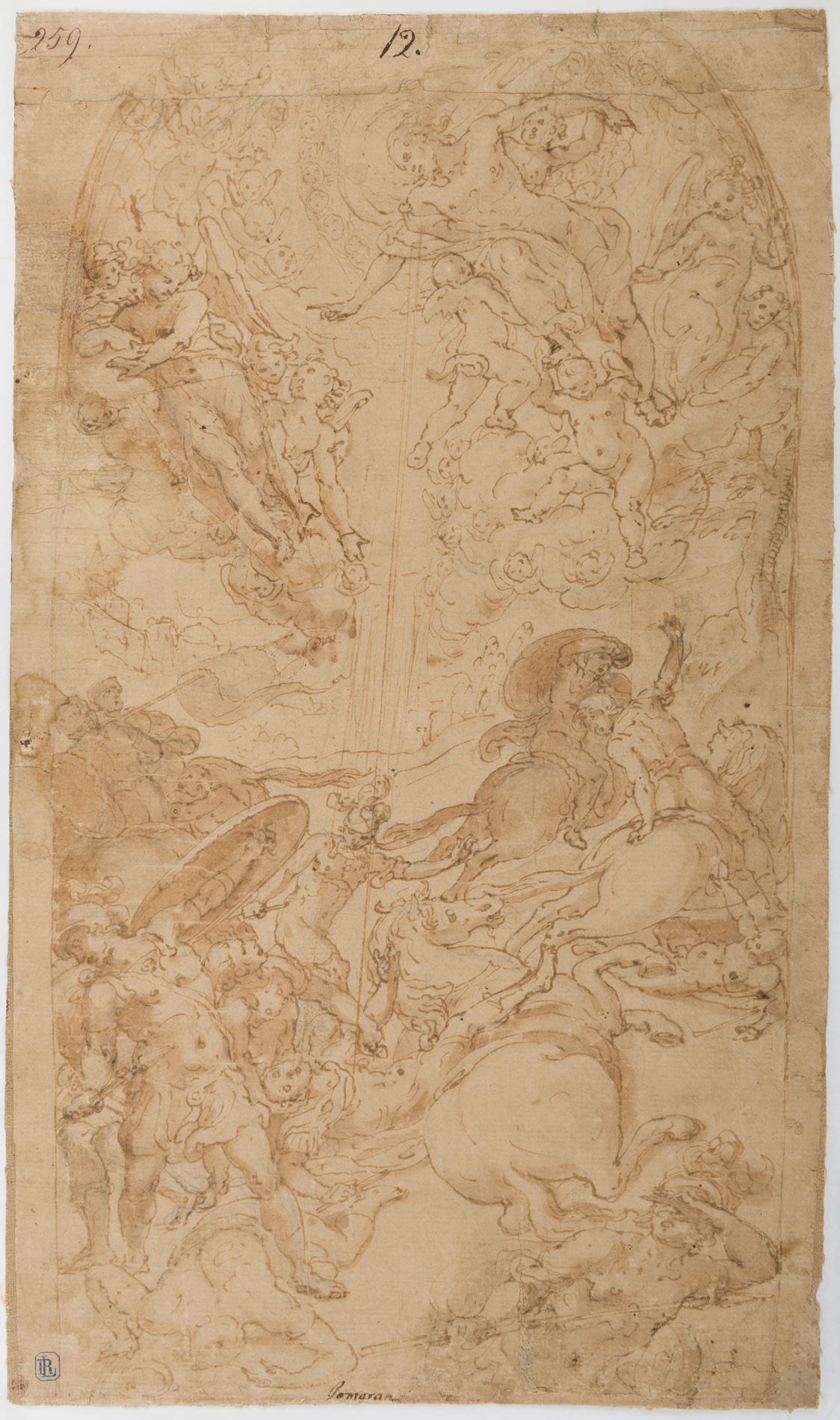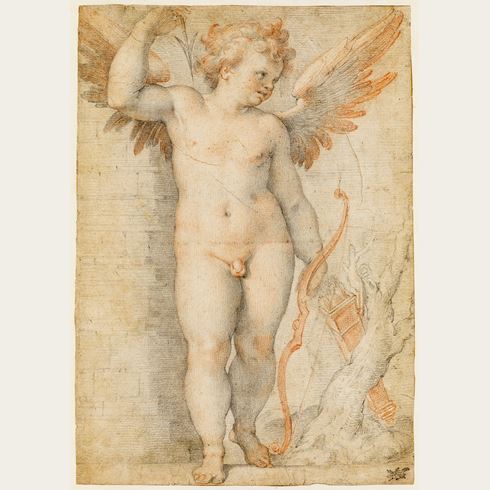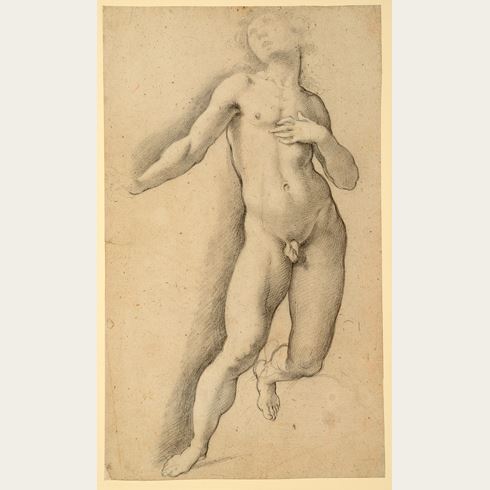Cristoforo RONCALLI
(Pomarance 1552 - Rome 1626)
The Conversion of Saint Paul
Sold
Pen and brown ink and brown wash, over an underdrawing in black chalk, on paper laid down on canvas.
The legs of an agel at the upper left and the right arm of a horseman at the right centre drawn on separate pieces of paper pasted onto the composition.
Numbered 259. and 12. at the top left and centre, and Pomarance at the bottom centre.
Inscribed Roncagli on the reverse of the canvas backing.
439 x 255 mm. (17 1/4 x 10 in.)
The legs of an agel at the upper left and the right arm of a horseman at the right centre drawn on separate pieces of paper pasted onto the composition.
Numbered 259. and 12. at the top left and centre, and Pomarance at the bottom centre.
Inscribed Roncagli on the reverse of the canvas backing.
439 x 255 mm. (17 1/4 x 10 in.)
This large sheet was first published by Ralf Scholz in 2007 as an early study for Roncalli’s fresco of The Conversion of Saint Paul in the church of Santa Maria in Aracoeli in Rome. However, in the final fresco, located in the fifth chapel in the north aisle of the church - dedicated to Saint Paul and also known as the Della Valle chapel - the subject was reduced to a lunette shape on the upper part of the left-hand side wall, above a large fresco of Saint Paul Preaching at Athens. Roncalli’s fresco decoration of the walls and ceiling of the Della Valle chapel with scenes from the life of Saint Paul – much of which has since been severely damaged by damp - can be dated to between 1584 and 1586. If this large sheet is indeed related to the Conversion of Saint Paul in the Della Valle chapel, it suggests that Roncalli may have initially planned the fresco of this subject to cover the entire wall, before choosing instead to divide the wall into two separate compositions, with the Conversion of Saint Paul as a lunette above the Saint Paul Preaching at Athens. It is also possible that the present sheet may have been a study for a now-lost or never-executed altarpiece or fresco.
Another preparatory drawing by Roncalli that has been related to the lunette fresco of The Conversion of Saint Paul, in the collection of the British Museum, contains many of the same elements and details as the present sheet, and is closer in format to the final fresco. Among other stylistically comparable drawings by Roncalli is a pen and ink study of The Martyrdom of Saint Thomas of Canterbury in the Kupferstichkabinett of the Georg-August-Universität in Göttingen, which is a study for a lost fresco of c.1582.
An alternative attribution to the 16th century Sicilian-born artist Tomasso Laureti (c.1530-1602) has recently suggested by Marco Simone Bolzoni. Only a handful of drawings by Laureti, who was active in Bologna and Rome, are known. One of these, a study of The Martyrdom of Saint Catherine in the Louvre, displays some stylistic similarities with the present sheet. Previously attributed to Roncalli, the Louvre drawing has been related by Bolzoni to Laureti’s altarpiece of The Martyrdom of Saint Catherine in the Bolognese church of Santa Maria Maddalena in Strada San Donato.
Another preparatory drawing by Roncalli that has been related to the lunette fresco of The Conversion of Saint Paul, in the collection of the British Museum, contains many of the same elements and details as the present sheet, and is closer in format to the final fresco. Among other stylistically comparable drawings by Roncalli is a pen and ink study of The Martyrdom of Saint Thomas of Canterbury in the Kupferstichkabinett of the Georg-August-Universität in Göttingen, which is a study for a lost fresco of c.1582.
An alternative attribution to the 16th century Sicilian-born artist Tomasso Laureti (c.1530-1602) has recently suggested by Marco Simone Bolzoni. Only a handful of drawings by Laureti, who was active in Bologna and Rome, are known. One of these, a study of The Martyrdom of Saint Catherine in the Louvre, displays some stylistic similarities with the present sheet. Previously attributed to Roncalli, the Louvre drawing has been related by Bolzoni to Laureti’s altarpiece of The Martyrdom of Saint Catherine in the Bolognese church of Santa Maria Maddalena in Strada San Donato.
Little is known of Cristoforo Roncalli’s artistic training. Known as Il Pomarancio after his birthplace of Pomarance, he is first documented working in Siena between 1576 and 1579. During this period he painted an altarpiece for the Duomo and collaborated on the decoration of a family palazzo, and also received a commission for an altarpiece intended for the church of SS. Apostoli in Florence. Roncalli then settled in Rome, where he is recorded by 1582, and was active there for the remainder of his career. He was associated with a circle of artists active in the city that included his compatriot Niccolò Circignani (confusingly also known as Il Pomarancio) as well as Cavaliere d’Arpino, Cesare Nebbia and Paris Nogari. Roncalli received numerous public and private commissions, and was admitted to the Accademia di San Luca in 1588.
He earned a reputation as an ecclesiastic mural painter of the first rank, gaining the patronage of such Roman families as the Crescenzi, Mattei and Giustiniani, and working in the churches of Santa Maria in Aracoeli, San Giovanni Decollato, Santa Maria in Vallicella and San Silvestro in Capite in Rome. Between 1599 and 1604 he supervised the decoration of the Cappella Clementina in St. Peter’s for Pope Clement VIII, and also worked for the Pope on the decoration of the transept of San Giovanni in Laterano. Around 1607 Roncalli was named a cavaliere di christo by Pope Paul V, shortly after receiving the most significant commission of his career; the fresco decoration of the sacristy and cupola of the Basilica of the Santa Casa at Loreto, on which he worked between 1605 and 1615. On his return to Rome, Roncalli spent the last decade of his career working on more modest commissions.
An exceptional draughtsman, Roncalli worked for the most part in both black and red chalk, switching easily between them for both compositional and figural studies, although using the former slightly more in the 1580’s and 1590’s. (While a number of pen drawings by the artist are known, after the 1580’s he seems to have worked almost exclusively in chalk.) His earliest datable drawings – studies for works of the late 1570’s, as well as copies after Raphael - already show a mastery of form and line and a sophistication that would be characteristic of the artist’s drawings throughout his career. The largest extant group of drawings by Roncalli is today in the Uffizi.
Provenance
Col. Count Raffaello Ettore Lamponi Leopardi, Florence and Turin (Lugt 1760)
His posthumous sale, Florence, Borgo Pinti [Jules Sambon], 10-19 November 1902, lot 372 (as Santi di Tito: ‘La Conversion de St. Paul. Plume et bistre.’)
Anonymous sale, Berlin, Galerie Bassenge, 30 November 2018, lot 6422
Private collection, Rome.
His posthumous sale, Florence, Borgo Pinti [Jules Sambon], 10-19 November 1902, lot 372 (as Santi di Tito: ‘La Conversion de St. Paul. Plume et bistre.’)
Anonymous sale, Berlin, Galerie Bassenge, 30 November 2018, lot 6422
Private collection, Rome.
Literature
Rolf Scholz, ‘Neu aufgefunden: Modello einer Caduta da cavallo von Cristoforo Roncalli’, Das Münster: Zeitschrift für christliche Kunst und Kunstwissenschaft, 2007, No.2, pp.110-113, fig.1-3.





 Cristoforo-RONCALLI-TheVirginandChildwithSaintAnne-1862014T184748.jpg?width=490&height=490&qlt=80&mode=pad&bgcolor=F1EEE7)

